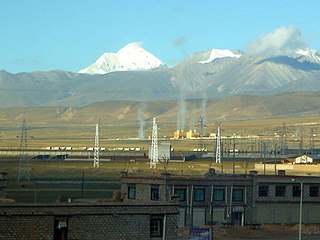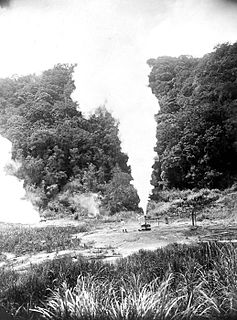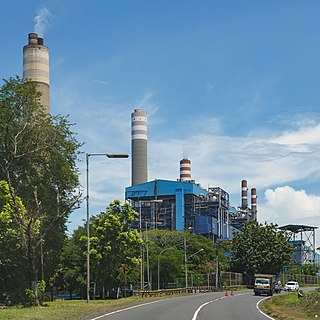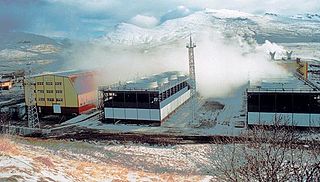
The Moss Landing Power Plant is a natural gas powered electricity generation plant located in Moss Landing, California, United States, at the midpoint of Monterey Bay. Its large stacks are landmarks, visible throughout the Monterey Bay Area. The plant is owned and operated by Houston-based Dynegy and currently has a generation capacity of 1020 MW (net) from its two combined cycle generation units. It was once the largest power plant in the state of California, with a generation capacity of 2560 MW, before its two large supercritical steam units were taken offline.

Kamojang, popularly known as Kawah Kamojang or, is a geothermal field and tourist spot in West Java, Indonesia. The crater is located in sub-district (kecamatan) Ibun in the Bandung Regency, approximately 45 km to the southeast of Bandung through the towns of Majalaya and Ibun. The crater can also be reached from the opposite direction through the town of Garut, in Garut Regency.

PT Perusahaan Listrik Negara (Persero) is an Indonesian government-owned corporation which has a monopoly on electricity distribution in Indonesia and generates the majority of the country's electrical power, producing 176.4 TWh in 2015. It was included in the Fortune Global 500 lists of 2014 and 2015.

Geothermal energy in the United States was first used for electric power production in 1960. The Geysers in Sonoma and Lake counties, California was developed into what is now the largest geothermal steam electrical plant in the world, at 1,517 megawatts. Other geothermal steam fields are known in the western United States and Alaska. Geothermally generated electric power can be dispatchable to follow the demands of changing loads. Environmental impact of this energy source includes hydrogen sulfide emissions, corrosive or saline chemicals discharged in waste water, possible seismic effects from water injection into rock formations, waste heat and noise.

Geothermal power is power generated by geothermal energy. Technologies in use include dry steam power stations, flash steam power stations and binary cycle power stations. Geothermal electricity generation is currently used in 26 countries, while geothermal heating is in use in 70 countries.

Geothermal exploration began in China in the 1970s. It was initially handled by national bodies with public investments, and productive wells were transferred free of charge to the final user. Since the mid-1980s, under the framework of privatization and liberalization of the economy, national investment in exploration has been reduced. No new plants have been commissioned in the period 2000–2005. The only electricity-producing fields are located in Tibet. According to the "2005 Chinese Geothermal Environment Bulletin" by China's Ministry of Land and Resources, the direct utilization of geothermal energy in China will reach 13.76 cubic meters per second, and the geothermal energy will reach 10,779 megawatts, ranking first in the world.
The Cirebon Steam Power Plant is a 660 MW coal-fired power plant developed by PT Cirebon Electric Power (CEP) in the Kanci area to the southeast of Cirebon, Indonesia. The first unit of the plant was launched in mid October 2012. The reported cost of the plant was around $US 850 million. Construction began in 2008 and was substantially completed, a little behind time, in mid-2012. Sales from the plant to the Indonesian state-owned electricity company Perusahaan Listrik Negara (PLN) began on 27 July 2012.
The Wayang Windu Geothermal Power Station is the largest geothermal power station in Indonesia. The facility utilizes two units, one with 110 MW and the other with 117 MW, with a total installed capacity of 227 MW. The power station is located near the town of Pangalengan, 40 km south of Bandung, West Java. An estimated cost of US$200 million was incurred in construction and development. A third unit of 127 MW is being planned and expected to be onstream by mid-2013.

Geothermal power in Indonesia is an increasingly significant source of renewable energy. As a result of its volcanic geology, it is often reported that Indonesia has 40% of the world's potential geothermal resources, estimated at 28,000 megawatts (MW).

The Ostrołęka Power Station is a coal-fired thermal power station in Ostrołęka, Poland. It is owned by Energa.
Energy in Indonesia describes energy and electricity production, consumption, import and export in Indonesia. In 2009 Indonesia produced oil, coal, natural gas and palm oil, utilised also as energy raw material in 2010. Renewable energy potential in Indonesia is high: solar, wind, hydro and geothermal energy. Tropical rain forests and peat land areas have extensive coal storage. Indonesia is a geologically unstable country. According to IEA Indonesia was the 10th top natural gas producer in 2009: 76 billion cubics (bcm) 2.5% of world production of which 36 bcm was exported. In 2009 Indonesia was the 5th top coal producer: 263 million tonnes hard coal and 38 million tonnes brown. The majority of this, 230 Mt of hard coal, was exported. Indonesia has significant energy resources, starting with oil – it has 22 billion barrels of conventional oil and gas reserves, of which about 4 billion are recoverable. That's the equivalent of about 10 years of oil production and 50 years of gas. It has about 8 billion barrels of oil-equivalent of coal-based methane (CBM) resources. It has 28 billion tonnes of recoverable coal and has 28 gigawatts (GW) of geothermal potential.
Phú Mỹ Power Plants is a power generation complex located in Phú Mỹ, Tân Thành District, Bà Rịa–Vũng Tàu Province, Vietnam. The complex is located next to Thị Vải River. Its combined generation capacity is 3,900 MW providing about 40% of Vietnam's total electricity. The complex consist of Phú Mỹ 1, 2-1, 2-2, 3 and 4 power plants.
The Kızıldere Geothermal Power Plant is a geothermal power plant located at Kızıldere village of Sarayköy district in Denizli Province, southwestern Turkey. The initial power plant with 15 MW installed capacity was expanded in the second phase about 80 MW to 95 MW in total, making the facility Turkey's biggest geothermal power plant. It is planned to expand the power plant in a third and fourth phase.

Paiton Power Station is a large thermal power station located around 35 km to the east of the town of Probolinggo in East Java in Indonesia, about half way between Probolinggo and Situbondo. The extensive complex has a maximum generating capacity of 4,710 megawatts. It is the largest power station in Indonesia and the 10th largest coal-fired power station in the world.

Mutnovskaya power station is a geothermal power plant. It is the largest geothermal power plant in Russia, 60 km south from the administrative center of Petropavlovsk-Kamchatka region, on the bank of the Falshivaya River. Its capacity is 50 MW. The plant is operated by Geotherm JSC, a subsidiary of PJSC RusHydro.

PT Bekasi Power is a power plant located in West Java, Indonesia. It is a subsidiary of PT Jababeka Tbk which was established in 2007. As a 130 megawatt (MW) power plant generated by steam and gas (PLTGU), it strengthens Bekasi – Karawang electricity system through Cibatu substation owned by PT Perusahaan Listrik Negara (PLN). This state-owned company can only meet the needs of about 60 percent. To meet the rest, private sector needs to get involved. A reliable and sustainable electricity supply with an international standard is a must for an industrial estate. Bekasi Power plant is therefore constructed to guarantee Uninterruptible Power Supply (UPS) for a total of seven industrial zones including Jababeka. By delivering reliable electricity at a competitive price, this plant supports Jababeka business as well as surrounding areas, boosting Indonesia's power capacity and industrial growth for the upcoming years.

The Mammoth Geothermal Complex is a complex of 3 geothermal power stations located at Casa Diablo Hot Springs about 3 miles (4.8 km) east of Mammoth Lakes, California. The complex is owned by Ormat and operated by its subsidiary Mammoth Pacific.
AC Energy Inc. or simply AC Energy is the investment of Ayala Corporation in the power sector engaging primarily in greenfield or brownfield projects, renewable energy, and conventional technologies.












